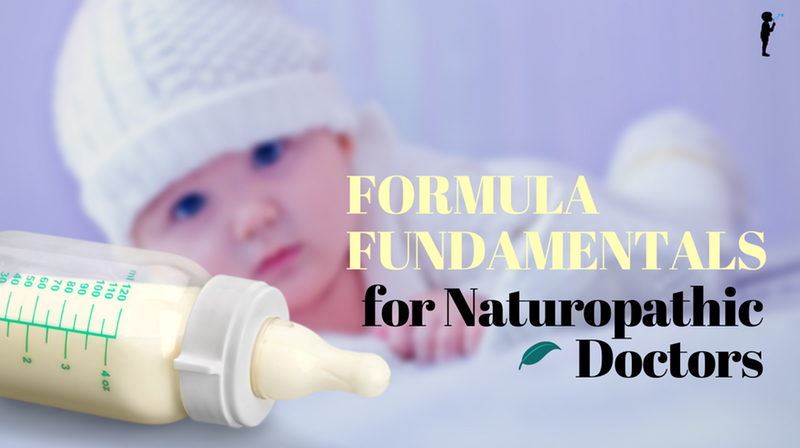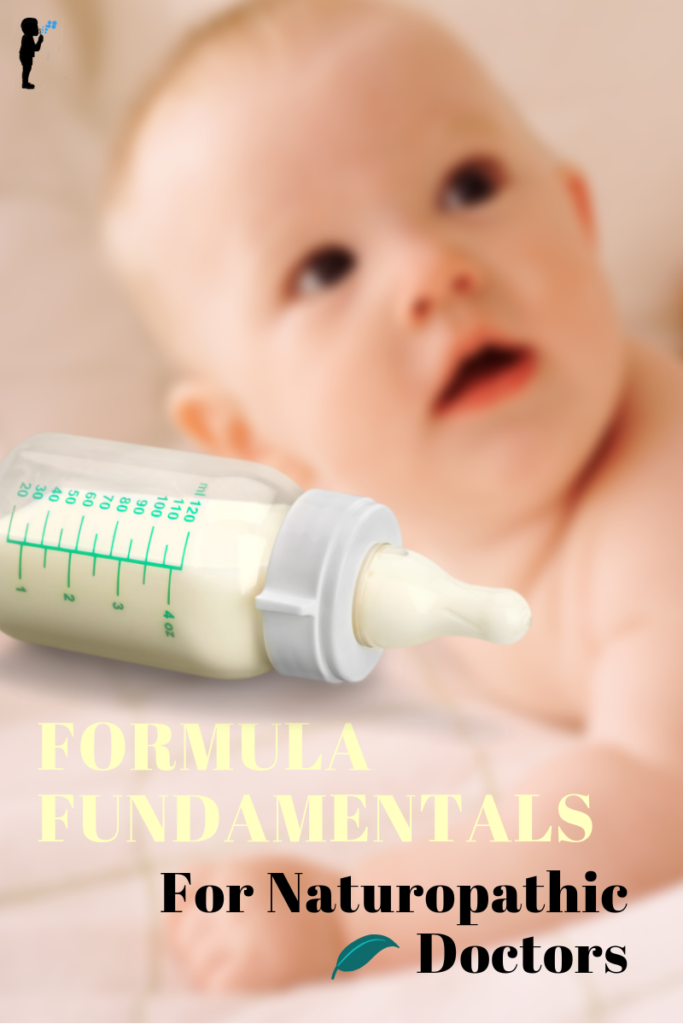
Formula Fundamentals for Naturopathic Doctors
A note from your editor: here at Naturopathic Pediatrics we strongly support breastfeeding as the optimal way to nourish infants. When breastfeeding is not possible and donor milk is not available we want to give families accurate information to help them choose the right breastmilk substitute. This article below is a Sponsored Post by Kabrita USA. Ashley Weber, ND shares some commonly asked questions and corrects some misinformation about formula ingredients. This article is intended for naturopathic doctors.
Every parent’s feeding journey with his or her baby is unique. Breast milk is the optimal source of nutrition for babies and breastfeeding should be encouraged with all available resources provided. However situations may arise where families need or choose to use formula. Healthcare practitioners should be equipped with accurate, up-to-date information to help guide patients. This article is intended to provide an overview of some of the more frequent questions that may be encountered in a Naturopathic practice.
Formula 101: decoding the ingredients
The guiding principle of baby formula is to model the nutritional composition of breast milk, as best as possible. Since no milk alone provides adequate nutrition for babies, all formula is adapted and fortified. The FDA sets parameters for nutritional content to ensure adequate growth.
In the US, formulas contain a non-fat protein source, such as cow, goat or soy milk. Whey and casein are two groups of proteins found in breast milk, as well as cow and goat milk. Breast milk contains a 60:40 whey to casein ratio, while cow and goat contain significantly less whey, with a 20:80 ratio. Many formulas add whey protein to better simulate the whey to casein ratio found in breast milk. This adapted ratio may also serve to improve digestibility.
Carbohydrates provide almost half of the calories in breast milk and are added to formula as an important energy source for babies. Sources of carbohydrates used in formula may include lactose, maltodextrin, corn syrup solids and/or glucose syrup solids.
Fats are added to model the types of fatty acids found in breast milk. Since no single fat source can simulate the fatty acid profile found in breast milk, a blend of plant-based oils are typically used, and may include sunflower, safflower, coconut, soybean and/or palm oil.
Finally, baby formula contains added micronutrients, vitamins and minerals, to meet the unique nutritional needs of little ones.
Choosing goat milk based formula
Goat milk is preferred over cow milk based formula among many ND’s and their patients. Goat milk formula is also gaining in popularity!
Goat milk alone (non-hydrolyzed) is not nutritionally suitable for infants and contains excessive protein, sodium and potassium, inadequate carbohydrates, and lacks a number of important micronutrients (notably, folate). Parents may have questions about goat milk formula; here are three key points you may wish to review.
1) Goat milk is easier to digest than cow milk
Goat milk contains less alpha S1-casein than cow milk, resulting in a softer, smaller and looser curd in the gut compared to cow milk protein, making it easier to digest. Recent research has also shown that goat milk formula is digested at a rate closer to breast milk, compared to cow milk formula.
2) Goat milk formula may have clinical benefits
Digestibility differences may result in clinical benefits. For children with symptoms associated with cow milk sensitivity,* goat milk formula may be a solution. Case studies have shown significant improvement or resolution of atopic dermatitis, loose stools, chronic regurgitation and chronic congestion.
3) Goat milk is naturally rich in nutrients
Goat milk contains 6 times the amount of oligosaccharides (prebiotics) as cow milk, and goat milk based formula contains 4-5 times the amount of free nucleotides (building blocks for DNA and RNA) than cow milk based formula.
Concerns about soybean oil or palm oil
Breast milk delivers 40-50% of its energy from fat and contains a unique fatty acid profile and triglyceride structure.
Soybean oil is a source of both linoleic and oleic fatty acids and is often used in baby formula. Concerns over soy stem from possible allergic and hormonal response associated with soy protein. While this may be a concern for soy protein based-formula, soybean oil is free of soy protein and therefore allergic and hormonal concerns are avoided. Additionally, up to 90% of soy in North America is genetically modified and may be a concern for some. If this is a concern, seek out organic and/or non-GMO formula.
Palm oil is a source of critical palmitic acid, a fatty acid that makes up almost one quarter of the fat in breast milk. While palmitic acid has been linked to calcium soap formation, this is associated with the structure of the triglyceride and not the palmitic acid itself.
Should formula contain lactose?
Lactose is the primary carbohydrate found in breast milk, and provides an important source of energy. Research has shown that lactose may benefit the gut microbiota and help with the absorption of calcium in babies.
Lactose is the preferred source of carbohydrates for most babies. While lactose intolerance may become more common as children get older, it is uncommon before 2 or 3 years of age. Most babies will produce sufficient amounts of the enzyme lactase, required to break down lactose in breast milk or formula for absorption. For babies with rare disorders like galactosemia or congenital lactase deficiency, a strict lactose-free formula is a medical necessity.
Questions about folic acid
Folate is an important vitamin in pediatric development, supporting production of DNA and amino acids and healthy cell division. All infant formula contains added folic acid.
As per the FDA, infant formula is required to contain 4 mcg of folic acid per 100 kcal. At this time, folic acid is the only form of this vitamin approved by the FDA for use in infant formula.
Folinic acid and 5-methyltetrahydrafolate (5-MTHF), two other forms of folate, are not approved for use in infant formula in the US.
Homemade baby formula
For some families needing to use formula, commercially available formula may not seem like the ideal choice. These families may look for an alternative option in the form of homemade baby formula.
Health professionals should understand that homemade formulas do not meet the safety guidelines of commercially available formulas, and may pose potentially serious consequences. One of the major concerns with homemade formulas is inconsistent recipes and ingredients, as slight nutritional variations can lead to serious nutritional imbalances over time. Ingredients in homemade formulas are unregulated and may be a source of pathogens. Mixing errors and contamination of preparation environment also pose serious risks to infants.
Commercially available infant formulas in the US conform to rigorous regulatory standards. For example, all infant formulas must complete a clinical trial demonstrating safety and adequate growth in infants and meet FDA nutrient guidelines. Formulas must also demonstrate nutrient stability through shelf life studies and perform strict microbiology testing for harmful pathogens.
Due to the potential for serious health consequences, experts do not recommend homemade baby formula.
Supporting Your Patients
Breast milk is the optimal source of nutrition for babies, and families should be provided the resources needed for breastfeeding. Still, there are many situations where formula is chosen or needed. For babies with serious medical issues, a specialty formula may be required, such as a hydrolyzed or elemental formula, and referral to a specialist may be warranted.
As naturopathic doctors, it is our duty to provide non-judgmental support, and educate patients about their feeding options to foster informed choice.
Kabrita goat milk toddler formula is the first goat milk formula available in the US. Kabrita contains naturally easy to digest goat milk protein and an adapted whey:casein ratio. Kabrita is made with high quality goat milk from the Netherlands, certified non-GMO and Glyphosate-residue free, and meets the FDA nutritional guidelines for infant formula. Kabrita is currently working on bringing an infant goat milk formula to the US, with plans for a late 2019 release.
Are you a healthcare practitioner and would like to try Kabrita goat milk formula with your patients? Request free samples for your practice here.
Are you a parent looking to try Kabrita? Click here to claim your free trial offer!

*Goat milk is not suitable for children with confirmed cow milk protein allergy
References:
Francavilla R, et al. Effect of lactose on gut microbiota and metabolome of infants with cow’s milk allergy. Pediatr Allergy Immunol. 2012 Aug;23(5):420-7.
Hae-Soo K, et al. Revisiting lactose as an enhancer of calcium absorption. International Dairy Journal. 2012;22(2):147-151.
Heyman MB (Committee on Nutrition). Lactose intolerance in infants, children, and adolescents. Pediatrics. 2006. Sep;118(3):1279-86.
Maathuis, A, et al. Protein Digestion and Quality of Goat and Cow Milk Infant Formula and Human Milk Under Simulated Infant Conditions. JPGN. 2017 Dec;65(6):661-666.
Milner, JA, Allison RG. The Role of Dietary Fat in Child Nutrition and Development: Summary of an ASNS Workshop. The Journal of Nutrition. 1999 Nov;129(11):2094-2105.
Park YW. Hypo-allergenic and therapeutic significance of goat milk. Small Rumin. Res. 1994 Aug;14(2):151–16.
Park YW., et al., Physico-chemical characteristics of goat and sheep milk. Small Ruminant Research, 2007. 68(1):88-113.
Pellis, L, at al. Naturally high content of nucleotides in goat milk based infant formula. Poster presented at PAS, Toronto, Canada, 2018.
Urashima, T., & Taufik, E. (2011). Oligosaccharides in Milk: Their Benefits and Future Utilization. Media Peternakan, 2010 Dec; 33(3):189-197.



Sarah Cummings
November 22, 2018 at 2:42 amThis is so informative! Very helpful even for us the readers. Great post! 🙂